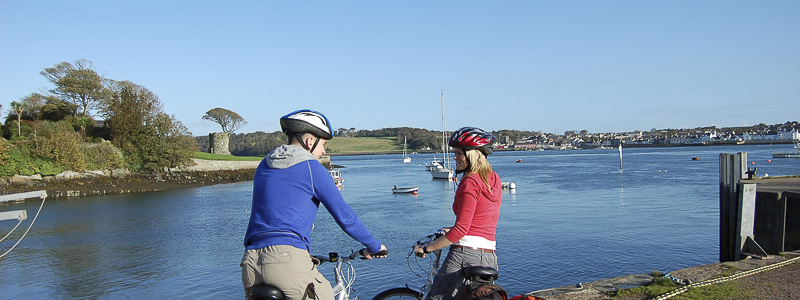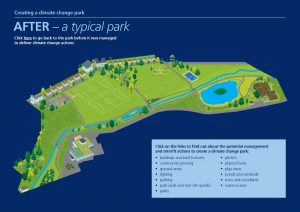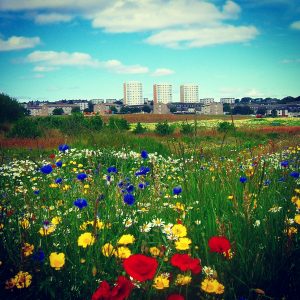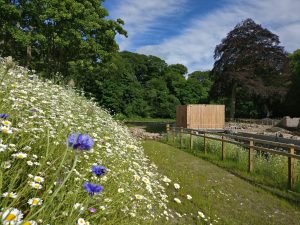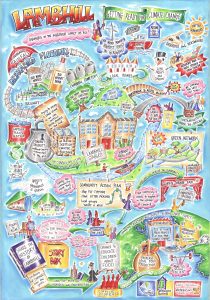By Deryck Irving, Programme Manager, greenspace scotland
(in Volume 28)
About greenspace scotland
greenspace scotland is social enterprise and an independent charitable company. We work with a wide range of national and local partners to improve the quality of life of people living and working in urban Scotland through the planning, development and sustainable management of greenspaces as a key part of the green infrastructure of our towns and cities. Our holistic approach recognises that greenspace is a ‘vehicle’ for delivering a wide range of quality of life and quality of place outcomes. We provide a range of services and projects through two overarching programmes: ‘demonstrating success’ and ‘supporting delivery’.
Climate change greenspace
In 2011, we convened a group of greenspace practitioners and climate change experts to consider the ways in which the design and management of urban greenspaces could deliver on national and local commitments to climate change action (both mitigation and adaptation). From this discussion, we produced a resource pack ‘Developing the role of greenspace in climate change mitigation and adaptation’ which identified a range of potential actions which could maximise the benefits accruing from greenspace.
We were keen to stress to greenspace managers and users that this was not about moving greenspaces away from their primary functions but more about recognising that:
1. Relatively small changes to the way existing spaces are managed could have noticeable impacts
2. Many of the proposed actions were already under consideration for other reasons (biodiversity improvements, active travel, cost savings etc.) but could be reframed in terms of climate change
3. This reframing highlights an additional reason why quality greenspace is important (particularly pertinent at a time of constrained public finance) – ‘if you’re not showing that you’re targeting climate change, you’re missing a trick’
As a follow up from this initial resource, we began work on a range of climate change projects including the production of a more focused document looking at public parks as the most multi-functional of greenspaces and, therefore, the typology where this kind of management change could most easily be accommodated. The expectation was that this would provide a starting point for planning changes to other types of greenspace. The parks resource ‘Retrofitting urban parks to deliver climate change actions’ envisages a series of design and management changes in a ‘typical’ urban park. For each of the key elements of the park, changes are discussed which will:
1. Reduce emissions and energy use
2. Minimise the impacts of climate change on the local area
3. ‘Capture’ any benefits from the changing climate (increased use of the outdoors for example)
Other rationales for these changes and links to other agendas are also discussed.
Putting the concept into practice
Producing this resource highlighted that (at the time), while many of the management or design changes were happening in Scottish parks, they were generally being carried out for other reasons and climate change was not being considered. We decided, therefore, to work on a number of pioneer ‘climate change parks’. In each case, we were keen to ensure that the park was in need of a new management plan or similar strategy and that a climate change approach could, therefore, inform a process that the local partners already needed to happen.
The first of these pioneers was Hazlehead Park on the western outskirts of Aberdeen. Hazlehead is one of Aberdeen’s flagship parks. The park covers over 180 hectares including large areas of woodland, football pitches, golf courses, a pitch and putt course and an events field.
The park itself has memorial rose gardens, azalea and rhododendron borders, heather beds, a children’s play area, a pets’ corner and a significant collection of sculpture by a range of artists and heritage items which have been rescued from various places within the city.
Hazlehead sits within an overall city-wide green network. Several core paths run through or adjacent to the Park offering walking and cycling connections to other parts of Aberdeen. Hazlehead also sits within an overall habitat network for the City supporting biodiversity and the movement of wildlife. The woodland policies around the Park are particularly important in this context. The park sits at the top of a hill and surface water runoff from the parkland areas presents a very real flooding risk to neighbouring communities and community facilities such as schools.
The Climate Change Park plan was developed with Aberdeen City Council and the Friends of Hazlehead and both have since used it to inform management and business plans. Climate change informed actions which have been implemented at Hazlehead (to date) include: exploration of the potential for biomass production from the plantation woodlands in the park and steps to ensure the succession/replacement of specimen trees; redesign of planted areas to eliminate peat use and to increase climate resilience and bringing the 1960s café back into use with 21st century levels of building insulation and solar lighting.
The pet’s corner building is being renovated to create an education centre with a focus on climate change (climate change information is also included on new signage across the park). The building now has Aberdeen City Council’s first green roof and is heated though a local district heat network using ‘waste’ heat from the local crematorium. New public art is being created for the park including a fantastic sculpture trail created by the local primary school and based on the global Sustainable Development Goals.
The discussions around local flooding allowed Parks staff to make a case for a full hydrological study which has led to the installation of sustainable drainage solutions diverting surface water into retention ponds and out of the area through other greenspaces thus reducing flood risk to surrounding communities. The park partners have been successful in using the climate change focus to find funding opportunities which match their plans. This includes accessing funding for walking and cycling infrastructure by showing that the Park has the potential to provide active travel links for the west of the City. Hazlehead is also the proposed location for climate and green infrastructure research over the next couple of years.
Importantly, the impact of the climate change park work has not been restricted to Hazlehead Park. Aberdeen City Council has used the learning from Hazlehead to inform greenspace management across the City. For example, the new focus on climate change action has meant that a previously problematic area in the city’s Seaton Park has been re-engineered to create a wetland area which dramatically reduces flood risk from the nearby River Don. In Torry, the council led on a restoration project which has naturalised the East Tullos Burn – reducing flood risks and introducing a wildlife friendly management regime which creates an important green corridor and reduces both the costs and emissions related to the previous site management. This project had a high degree of community involvement and has received a number of environmental awards.
Most excitingly for us, this is not just about council action. Aberdeen Community Energy is an award-winning Community Benefit Society, set up in 2015 by the Donside Community Association (DCA). It aims to transform Donside Village into a sustainable community. A key project in delivering this vision is the building and operation of the Donside Hydro Scheme – Scotland’s first community-owned urban micro-hydro scheme. There is an obvious climate change driver for this renewable energy scheme but the group is embracing the climate change greenspace approach and the river corridor is now being managed for public use, water control and for biodiversity (it also looks incredible). They are now improving the riverside path and are working in partnership with the city council to connect their site to Seaton Park and beyond to create a multi-functional green corridor.
Work elsewhere
But it is not just Aberdeen, greenspace scotland has been working on climate change with councils and communities across Scotland – including a range of projects Glasgow.
Our climate change work in Glasgow began with ‘the Five Streets’ – an application of the climate change greenspace thinking to a series of street settings across the city. This focused on the potential to address flood risk, air pollution and the urban heat island effect through the retrofitting of greenspaces and other green infrastructure at a street level. It also allowed us to begin to explore the implications of climate change with several communities.
In 2014, we began work with Glasgow City Council and Adaptation Scotland to support one community-based organisation – Lambhill Stables – to explore the potential for climate change adaptation with the community in Lambhill. This work highlighted the need to start any conversation with an understanding of what is important to local people before moving on to consider the implications of climate change when addressing these priorities. Climate change is a ‘stress multiplier’ adding complexity and worsening existing social, environmental and economic challenges but may also offer opportunities for new ways of working to address these challenges (for example, through increased growing seasons for local food production or by encouraging more active, outdoor lifestyles).
Climate Ready Lambhill identified a long list of potential adaptation projects – many greenspace-based – some of which the community could take forward themselves but many where the community needed the intervention of ‘institutional partners’ such as the council to deliver change. We are continuing to support the Stables in taking forward climate change greenspace action (both directly and through partnership working with others). This includes developing a community food growing strategy and developing active travel links to, and through, key greenspaces. The community has also been successful in pressing the local authority to prioritise the creation of a drainage retention pond in the local cemetery to reduce flooding of the main road into Lambhill.
Where next?
We are discussing the next stages of our work on climate change greenspace with several local authorities and wider regional partnerships – generally with a strong focus on the role of communities and the impact of greenspace on urban sustainability. For example, Glasgow is one of the lead cities in ‘Connecting Nature’ – a new project funded through the EU Horizon 2020 Research and Innovation programme. This project is looking at the ways in which nature-based solutions can increase the sustainability and resilience of cities. As part of their involvement, Glasgow City Council is aiming to create an Open Space Masterplan for the whole city. This masterplan will identify the appropriate mix of green, blue and grey spaces across Scotland’s largest city; the connections between these spaces and the functions which this network of spaces will deliver as the city adapts to the challenges and opportunities brought by a changing climate. We have been asked to work as part of the project partnership with a focus on supporting communities to explore their expectations and their role in delivering change.
For more information contact: Deryck Irving, Programme Manager, greenspace scotland deryck.irving@greenspacescotland.org.uk
References:
GREENSPACE SCOTLAND (2011) Developing the role of greenspace in climate change mitigation and adaptation [online]. Last accessed on 30 June at URL:
http://greenspacescotland.org.uk/SharedFiles/Download.aspx?pageid=133&mid=129&fileid=49
GREENSPACE SCOTLAND (2012) Retrofitting urban parks to deliver climate change actions [online]. Last accessed on 30 June at URL:
http://greenspacescotland.org.uk/SharedFiles/Download.aspx?pageid=133&mid=129&fileid=308
GREENSPACE SCOTLAND (2013) Hazlehead Climate Change Park [online]. Last accessed on 30 June at
URL: http://greenspacescotland.org.uk/SharedFiles/Download.aspx?pageid=133&mid=129&fileid=425
GREENSPACE SCOTLAND (2016) Hazlehead Climate Change Park Project update [online]. Last accessed on 30 June at
URL: http://greenspacescotland.org.uk/SharedFiles/Download.aspx?pageid=133&mid=129&fileid=1558
Wildlife of East Tullos Burn, Aberdeen [online]. Last accessed on 30 June at
URL: https://www.facebook.com/Wildlife-of-East-Tullos-Burn-Aberdeen-896336697124421/
ACE Energy (2017) webpage [online]
URL: http://acenergy.org.uk/
GREENSPACE SCOTLAND (2013) The Five Streets – Town Centres and Climate Change Programme [online]. Last accessed on 30 June at
URL: http://greenspacescotland.org.uk/SharedFiles/Download.aspx?pageid=133&mid=129&fileid=438
Adaptation Scotland (2016) Climate Ready Lambhill [online]. Last accessed on 30 June at
URL:
http://www.adaptationscotland.org.uk/get-involved/our-projects/climate-ready-lambhill
Connecting Nature (2017) webpage [online]. Last accessed on 30 June at
URL: http://www.connectingnature.eu/
